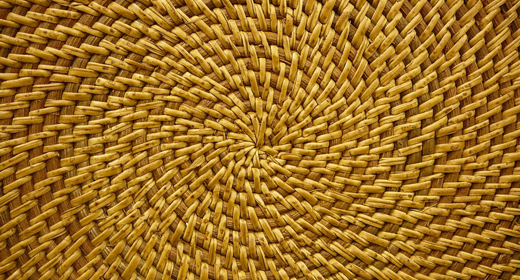Wicker world
- Marta Griffin | January 25, 2017

Today’s designers are weaving magic with traditional rattan and baskets, writes Eleanor Flegg
Basket-weaves offer the interesting shapes and textures beloved of contemporary designers, along with a poignant link to our rural past. The humble basket, yesterday’s disposable packaging, is taking its place as a decorative item in the modern home. Wicker, cane and rattan are shrugging off their hippie image to become interior design’s cool new material.
Gervasoni, the super-trendy Italian design company, has always used rattan, a refined form of wicker. Its new Slim collection is handwoven from natural mixed rattan into modern shapes.
The collection includes armchairs, sofas and beds, all in unfinished rattan or stained in a choice of four colours: natural, turquoise, white and coffee. As if to emphasise that the furniture has its roots in simply crafted work, it comes with an engaging collection of pillow-sack cushions — basically sacks tied at the top.
Irish baskets may have outlived many of their original uses, but they continue to be a much-loved feature in modern homes, capable of many contemporary interpretations. They cannot be mass produced, so they are all made by hand, either here or abroad.
Kathleen McCormick started making baskets because foreign imports did not have the character she was looking for. Now she has her own company, Basket Barn, in Co Meath, and has become known for her vibrantly coloured baskets, the colours coming from the natural colours of the willow.
“Different varieties of willow come in intense red, yellow, green, orange, gold and purple,” says McCormick. “Even the browns contain huge variations in colour. There’s no need for paint or dyes. Some of the colours mellow a little with age, but they don’t fade.”
McCormick finds her customers like to have baskets that perform practical roles. “One of the attractions of baskets is their functionality,” she says. “People use them especially for storing clothes and laundry. They’re very practical — clothes won’t go musty — and they look good. Bread and vegetables keep well because the weave allows air to circulate. Log baskets are popular too — that’s a use that hasn’t changed.
“The traditional shopping basket is still around, although these days you’re more likely to keep it by the door to store your purse, keys and plastic shopping bags.” McCormick’s prices start from about €60 for shopping baskets. Laundry and log baskets range from €70 to €130.
Other types of basket are purely decorative. One specifically Irish design, the sciob, was originally used for straining potatoes: the whole family then sat around the vessel and ate out of it. Sciobs are now popular as decorative wall-mounted pieces. A contemporary sciob will cost from €15 to €200, depending on size and colour.
Joe Hogan, one of Ireland’s best-known basketmakers, originally turned to the craft because it offered the promise of life in the Connemara countryside — not renowned for employment opportunities. “The initial attraction was the ease and speed with which willow could be grown. It’s a very convenient raw material,” says Hogan.
Hogan’s non-functional work is remarkable. Over the past 27 years he has almost single-handedly turned baskets into an art form. Some of his work includes willow catkins, their delicate furry shapes softening the lines of the wood so that the basket looks like an element of the tree. Others are built around twisted and weathered pieces of wood that were “too nice to be left behind”.
Irish baskets are more available these days, since specialist makers have spotted the demand for them.
Irene Kelly, who with her sister Barbara runs the Basketry Studio, a basket- weaving workshop in Co Wexford, says: “Most of the baskets we make are to order. People often want a basket for a particular space.
“We get a lot of orders for Moses baskets, which retail at about €75, and even more requests to repair baskets that have come down from the attic.”
Kelly adds: “Another way to use baskets is for recycling — one for glass, one for paper, one for plastics. It’s a handy way to take stuff to the dump, and they look a lot better than plastic storage bins.”


twitter
pinterest
email
rss